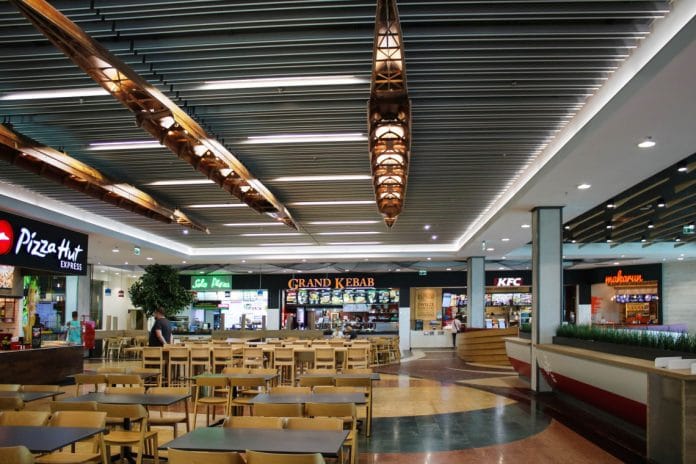Shopping centres, which are an integral part of Polish people’s lifestyle, are evolving with demographic, cultural and economic changes. In the past five years, food zones in about 50 shopping centres have been expanded or modernised, significantly improving their quality, extending their culinary offer and adding functions that increase comfort of use (e.g. facilities for families with children or coworking zones for freelancers).
During this time, 10 new shopping centres have been opened and the number of food outlets has increased by over 43% – these are the conclusions of the latest report by Colliers International entitled ‘How to eat it all? Gastronomy in Polish shopping centres’.
Chain tenants lead the way
In the shopping centres analysed by Colliers, there are over 2,300 different types of food & beverage outlets, 70% of which are concepts run by chain operators. Catering points in shopping centres appear both as regular premises and as catering stands. The former constitute 83%, the latter 15% and the remaining 2% are standalone premises.
Polish shopping centres are dominated by three food & beverage categories (according to the definition of ISCS): impulse (consumption in motion, includes ice cream, juices, snacks, etc.), refuel&relax (these are places aimed at rest and short breaks, such as Costa Coffee and Starbucks) and speed eating – the largest and most ‘chain’ category, which includes fast food restaurants, such as KFC, McDonald’s and North Fish.
Multifunctional food & beverage space
The share of food & beverage in shopping centres has increased in volume from 8.7% to 9.7%. Food courts have also changed, by improving their aesthetics, functionality and diversity.

“Spaces or dining areas with tables are now a thing of the past, giving way to functionally diversified spaces with bars, cafes, restaurants and various types of stands with delicacies. Wherever architecturally possible, there are seasonal terraces, outdoor gardens and lots of greenery and natural light. The food zone is becoming a multifunctional place, combining eating, spending free time and entertainment with a workplace. There are also attempts to animate food spaces by organising various events, meetings, shows and games (e.g. cooking workshops for children),” says Marta Machus-Burek, senior partner, director of the Retail Agency at Colliers International.
In terms of types of cuisine, the range remains quite standard – cafeterias / confectionery / ice cream parlours, international cuisine, American, Asian, Italian and Middle East cuisine. Interestingly, in terms of the number of food & beverage outlets, Asian cuisine is more popular than Italian. Middle East cuisine is also growing stronger. What is surprising is the relatively small presence of independent restaurants with typically Polish cuisine, which is present mainly as concepts that serve dishes by weight.
The operators with the largest number of foodservice points in the shopping centres analysed include: Grycan Lody od Pokoleń, KFC, McDonald’s, Costa Coffee, Cukiernia Sowa and Pizza Hut. However, the expansion of café chains in shopping centres has been limited – their share in the number of premises decreased in the period by more than 5 percentage points. One of the reasons may be changes in legislation (the Sunday trading ban).
What will the future bring?
Scenarios for the future of food & beverage in shopping centres should be considered in several aspects. Changes in consumer behaviour and factors directly affecting tenants’ operating activity will shape the coming years in the food & beverage sector.
Consumer food trends will be determined by factors such as the growing importance of environmental protection and a healthy lifestyle, curiosity about new tastes caused by travel and openness to other cultures, increased wealth, changes in lifestyle and family models and a lack of time. The return to tradition is also becoming popular. Nowadays, regional, ecological products produced in a traditional way are fashionable. Consumers are looking for community and intimacy. This trend includes breakfast fairs, the renaissance of markets, shared cooking and open-air picnics. All this shows a longing for community in opposition to the model of globalisation.

“Food service is increasingly reaching for the values offered by nature. An interesting phenomenon are seasonal ‘wild restaurants’, created by lovers of good food, local products and feasting in the bosom of nature. Outdoor food is something that consumers expect from shopping centres,” said Katarzyna Michnikowska, associate director, Research and Consultancy Services, Colliers International.
Factors affecting the business of catering tenants in shopping centres include excessive supply of gastronomic location, development of on-line sales and an increase in operating costs (lease, media and labour costs). The growing popularity of online orders and deliveries is posing new challenges for shopping centre owners. There is a need for parking spaces for couriers, and with the centralisation of kitchens away from centres there may be a need to reduce the rental space of catering premises. However, the biggest challenge for chains is to attract and retain employees, increase their salaries, as well as offering more expensive food, especially fresh products, which are expected by customers.
In the future, the foodservice sector will be changed by phenomena such as robotisation and artificial food production. In opposition to new technologies, the idea of zero waste, slow food and private cooking is growing in strength. It is a lifestyle that involves not wasting food, producing it for people’s use, sharing food and minimising waste. Shopping centres will have to reconcile these two opposing trends.


















